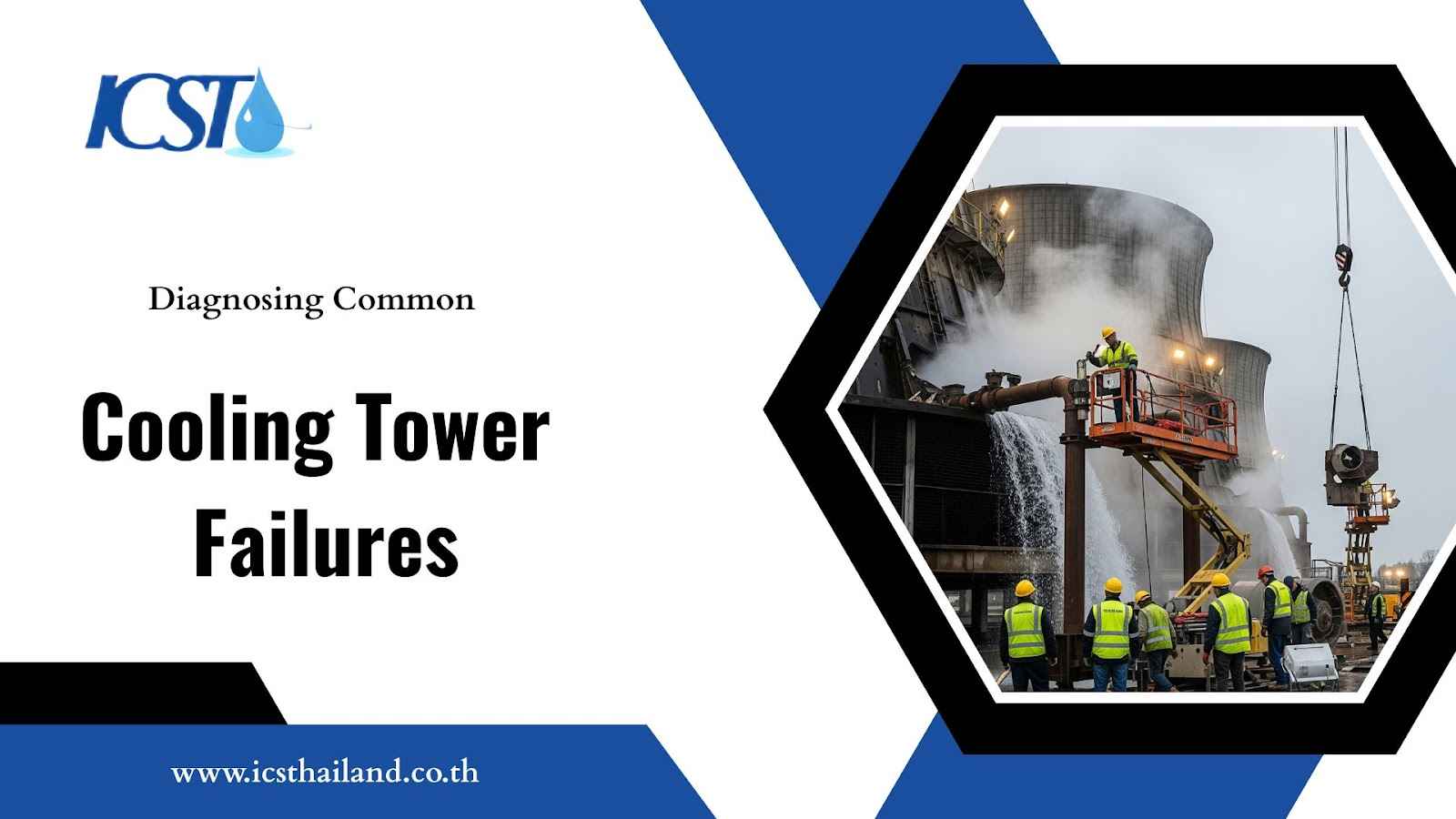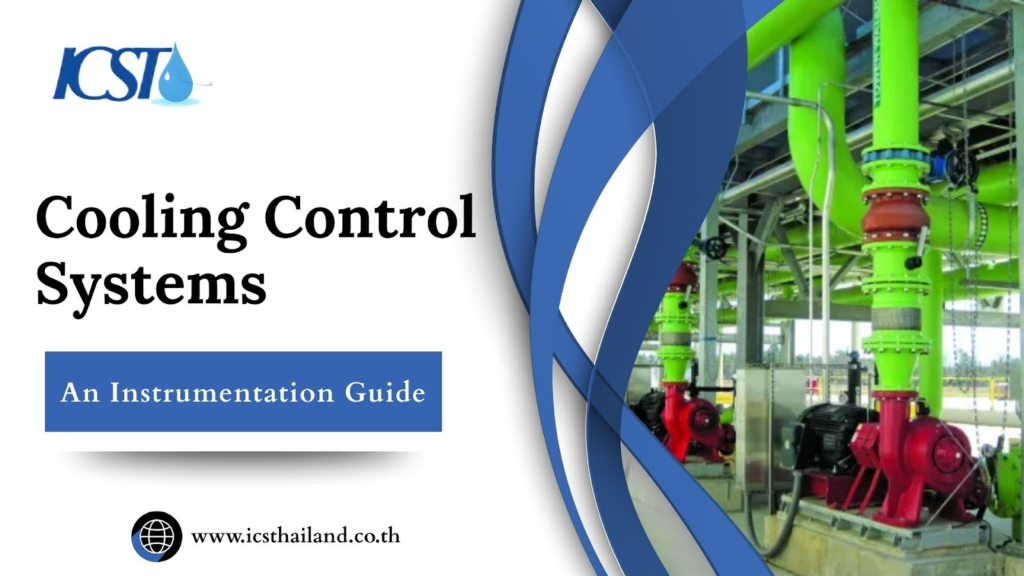When a cooling tower fails unexpectedly, the consequences ripple through your entire operation. Production lines halt, emergency repair costs skyrocket, and revenue bleeds away with every hour of downtime. These critical systems work around the clock to maintain optimal temperatures for your processes, yet many facilities only address issues after catastrophic failure strikes.
The harsh reality is that most cooling tower failures don’t happen overnight. They begin as subtle symptoms that gradually worsen, symptoms that trained eyes can catch early. A slight vibration in the fan assembly, uneven water distribution, or unusual motor amperage readings all signal developing problems that could shut down your system within weeks.
In this guide, you’ll discover how to turn reactive maintenance into proactive prevention. Learn to spot early warning signs of common failure points and take action before small problems escalate into major issues..
Table of Contents
ToggleWhy a Proactive Diagnosis is Critical
The maintenance world is shifting from “fix-it-when-it-breaks” to “find-it-before-it-breaks,” and for good reason. Proactive diagnostics deliver measurable benefits that transform both your maintenance budget and operational reliability.
- Reduce unplanned downtime: Catching bearing wear early allows you to schedule repairs during planned maintenance instead of dealing with emergency fixes.
- Lower repair costs: Replacing components before they fail prevents damage to connected systems. For example, replacing a worn bearing is far cheaper than replacing an entire motor or gearbox.
- Extend equipment lifespan: Proactive monitoring helps equipment, like cooling towers, operate efficiently for decades. In contrast, reactive maintenance often shortens their lifespan by years.
- Prevent structural damage: Addressing issues like water chemistry imbalances early avoids structural deterioration, keeping systems stable.
- Improve safety: Early detection eliminates risks, such as system instability or biological growth, ensuring a safer work environment.
Failure Point 1: The Fan and Drive System
The fan and drive system represents the mechanical heart of your cooling tower, moving thousands of cubic feet of air per minute through the system. When these components fail, heat transfer efficiency plummets immediately.
3.1 Symptoms of Fan and Drive Failure:
Watch for these telltale signs that indicate developing problems in your fan assembly:
- Unusual noises: Sounds like grinding, humming, or rattling may signal mechanical issues or misalignment.
- Unusual vibration: Higher vibration levels may indicate issues like imbalance, misalignment, or worn-out bearings
- Reduced airflow: Diminished air velocity from the tower top suggests fan blade or motor issues
- Component overheating: Hot motor housings or gearboxes indicate internal problems or overload conditions
3.2 Key Causes and Diagnostic Actions:
Misalignment or Imbalance:
Fan blades accumulate dirt, ice, or physical damage that creates an imbalance. Misalignment between the motor and gearbox leads to increased vibration and early wear.
Diagnostic Action:
- Use a vibration meter to pinpoint vibration sources and measure amplitudes.
- Conduct visual inspections of fan blades for debris accumulation, cracking, or deformation.
- Use precision tools to verify the alignment between the motor and gearbox.
Worn Bearings:
Inadequate lubrication or persistent misalignment accelerates bearing deterioration, leading to noise, heat, and eventual seizure.
Diagnostic Action:
- Listen for grinding or squealing noises during operation.
- Utilize thermal imaging cameras to detect heat anomalies on motor housings, bearing units, and gearbox parts.
- Monitor bearing temperatures regularly to establish baseline readings and detect anomalies.
Failure Point 2: The Water Distribution System
Efficient air-to-water contact depends entirely on proper water distribution across the fill media. Distribution problems create hot spots and reduce overall cooling effectiveness.
4.1 Symptoms of Distribution Issues:
These visible indicators reveal distribution system problems before they impact cooling performance:
- Dry spots on fill media: Uneven water coverage leaves portions of fill media without cooling water flow
- Irregular nozzle patterns: Spray heads producing weak, distorted, or blocked spray patterns
- Poor cooling performance: Higher cold water temperatures despite adequate airflow and proper water chemistry
- Uneven biological growth: Areas with reduced water flow develop more scale or biological deposits
4.2 Key Causes and Diagnostic Actions:
Clogged Nozzles or Spray Heads:
Debris, mineral scale, and biological growth gradually restrict water flow through distribution nozzles, creating uneven cooling patterns.
Diagnostic Action:
- Inspect each nozzle individually for blockages, scale buildup, or biological growth.
- Remove and examine strainers in the main water supply lines.
- Test spray patterns by observing water distribution across fill media during operation.
Incorrect Water Flow Rate:
Pump malfunctions, closed or partially closed valves, and piping restrictions reduce water flow below design specifications.
Diagnostic Action:
- Verify pump operational status, including motor amperage and pressure readings.
- Use flow meters to measure actual flow rates against design specifications.
Failure Point 3: Pumps and Motors
Pumps and motors provide the driving force behind water circulation, making them critical failure points that can shut down entire cooling systems instantly.
5.1 Symptoms of Pump and Motor Failure:
Early detection of pump and motor issues prevents sudden failures during critical operations:
- High amperage draw: Motors pulling excessive current indicate mechanical binding, overload, or electrical problems
- Unusual pump noises: Rattling, grinding, or cavitation sounds signal internal damage or operational issues
- Fluid leaks: Seal failures allow water to escape, reducing system efficiency and causing environmental concerns
- Excessive motor heat: Hot motor casings indicate overload conditions, poor ventilation, or internal electrical faults
5.2 Key Causes and Diagnostic Actions:
Motor Overload:
Mechanical problems within the pump, system blockages, or electrical faults cause motors to draw excessive current and overheat.
Diagnostic Action:
- Monitor motor amperage using clamp meters during startup and normal operation.
- Compare readings against nameplate specifications.
- Use thermal imaging to identify overheating components and check for proper ventilation around motor housings.
Cavitation or Bearing Failure:
Air entering the pump suction creates cavitation damage, while inadequate lubrication leads to bearing destruction and pump failure.
Diagnostic Action:
- Listen for sounds resembling gravel moving through the pump casing, indicating cavitation.
- Use vibration analyzers to detect bearing damage patterns and monitor bearing condition trends over time.
Failure Point 4: Fill Media and Casing
Fill media facilitates heat exchange between air and water, while the casing provides structural integrity for the entire system. Problems in these areas directly impact cooling effectiveness.
6.1 Symptoms of Fill and Casing Issues:
These indicators reveal problems with heat exchange components and structural elements:
- Poor cooling performance: Reduced heat transfer despite proper fan operation and water flow
- Visible scale buildup: White, brown, or green deposits on fill media surfaces that obstruct airflow
- Biological growth: Slimy biofilms or algae growth on fill surfaces and in water basins
- Structural damage: Cracks, corrosion, or leaks in tower basins, casings, and support structures
6.2 Key Causes and Diagnostic Actions:
Scaling, Fouling, or Biological Growth:
Improper water treatment allows mineral deposits and biofilms to accumulate on fill media, restricting airflow and reducing heat transfer efficiency.
Diagnostic Action:
- Conduct visual inspections of fill media from multiple angles.
- Scrape small samples of buildup for analysis to determine composition and appropriate treatment methods.
Structural Deterioration:
Age, inadequate maintenance, and corrosive conditions weaken tower structures, leading to safety hazards and operational problems.
Diagnostic Action:
- Perform thorough visual inspections of all structural components, including casings, panels, supports, and foundations.
- Check for corrosion, fractures, unsecured bolts, and indications of structural shifts.
- Document findings with photographs for trend analysis.
The Modern Diagnostic Toolkit: From Visual to Predictive
Technology is revolutionizing cooling tower diagnostics, enabling greater efficiency and minimizing costly operational disruptions.
IoT Sensors:
Advanced IoT sensors provide continuous, real-time monitoring of key parameters like temperature, vibration, and flow rates. These sensors issue instant alerts when anomalies are detected, allowing operators to address potential issues before they escalate.
Vibration Analysis:
Modern vibration analysis tools offer non-intrusive diagnostics to assess the health of rotating equipment. They help identify early signs of bearing wear, misalignment, and imbalance in critical components like fans, motors, and pumps.
Thermal Imaging Cameras:
High-tech thermal imaging cameras detect electrical and mechanical hotspots, such as overheating motors, failing electrical connections, and worn-out bearings. By visualizing heat patterns, operators can pinpoint the exact location of problems, ensuring precise and timely maintenance.
Together, these technologies support the shift from reactive maintenance (fixing equipment after it fails) to predictive maintenance. Repairs are scheduled based on real-time data and actual equipment conditions, optimizing maintenance schedules, reducing costs, and ensuring cooling towers operate at peak performance.
Quick Diagnostic Checklist
| Observed Symptom | Primary Area to Inspect | Potential Cause | Diagnostic Action |
| High Vibration/Noise | Fan & Drive System | Unbalanced fan, worn bearings, misalignment | Use a vibration meter, inspect blades, and check motor mounts |
| Poor Cooling | Water Distribution, Fill Media | Clogged nozzles, fouled fill, inadequate flow | Visually inspect nozzles/fill, check flow rate |
| Motor Overheating | Pump & Motor | Motor overload, bearing failure, and poor ventilation | Check motor amperage, use thermal camera |
| Water/Chemical Loss | Water Distribution, Casing | Leaks, broken pipes, cracked basin | Visual inspection of piping, seals, and casing |
| High Energy Use | Fan & Drive System, Pump | Overloaded motor, clogged fill, improper fan speed | Check motor amperage, inspect fill, verify VFD settings |
Conclusion
Every cooling tower failure has identifiable root causes and diagnosable symptoms that appear long before catastrophic breakdown occurs. The key to preventing costly failures lies in recognizing these early warning signs and taking corrective action immediately.
Proactive inspection programs, combined with modern diagnostic tools, represent the most effective approach to maintaining cooling tower health. Regular monitoring prevents costly breakdowns, ensures operational longevity, and protects your bottom line from unexpected repair expenses.
Avoid unexpected cooling tower failures from disrupting your operations. Partner with ICST for comprehensive diagnostic services, preventive maintenance programs, and expert repair solutions that keep your cooling systems running efficiently year-round.
Contact us today to transform your maintenance strategy from reactive to predictive.
Frequently Asked Questions
What are common signs of cooling tower problems?
Common signs include unusual noises (grinding, rattling), excessive vibration, a sudden drop in cooling performance (higher-than-normal cold water temperature), and visible issues like leaks or clogged nozzles. These symptoms often point to a developing failure.
What causes poor cooling performance?
Poor performance is typically caused by a combination of factors, including restricted airflow, fouled or scaled fill media, and clogged water distribution nozzles. These issues prevent proper air-to-water contact, which is necessary for efficient heat rejection.
What role does water chemistry play in failures?
Poor chemistry leads to scale, corrosion, and biological growth, which are the root causes of many mechanical failures.
Is it better to repair a cooling tower or replace it?
This depends on the extent of the damage. Minor issues like clogged nozzles or a worn fan can be repaired, but widespread corrosion, significant structural damage, or a completely fouled fill media may make replacement a more cost-effective long-term solution.








